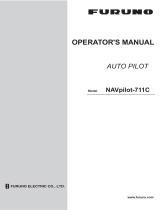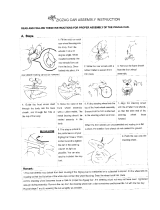
iii
TABLE OF CONTENTS
FOREWORD................................................................................................................... vi
SYSTEM CONFIGURATION ......................................................................................... vii
1. INTRODUCTION....................................................................................................1-1
1.1 Controls ......................................................................................................................1-1
1.1.1 Control Unit FAP-7001 ...................................................................................1-1
1.1.2 Control Unit FAP-7011 ...................................................................................1-2
1.1.3 Control Unit FAP-7021 ...................................................................................1-2
1.2 How to Turn Power On, Off ........................................................................................1-3
1.3 How to Adjust Brilliance, Contrast ..............................................................................1-4
1.3.1 NAVpilot-700 ..................................................................................................1-4
1.3.2 NAVpilot-711, NAVpilot-720 ...........................................................................1-4
1.4 Displays in the STBY, AUTO, NAV, WIND and FishHunter
TM
Modes .......................1-5
1.4.1 Content of displays in the STBY, AUTO, NAV, WIND and
FishHunter
TM
modes......................................................................................1-5
1.4.2 Graphic displays.............................................................................................1-9
1.4.3 How to select the data to show in the STBY mode ......................................1-12
1.4.4 How to select displays from the menu..........................................................1-13
2. STEERING MODES...............................................................................................2-1
2.1 STBY Mode ................................................................................................................2-1
2.2 AUTO Modes..............................................................................................................2-2
2.2.1 AUTO mode ...................................................................................................2-2
2.2.2 ADVANCED AUTO mode ..............................................................................2-4
2.3 NAV Mode ..................................................................................................................2-5
2.3.1 How to get the NAV mode..............................................................................2-5
2.3.2 Sailing method for the NAV mode ..................................................................2-8
2.3.3 Waypoint switching method............................................................................2-9
2.3.4 How to set the steering behavior of your boat after you arrive to a waypoint.2-9
2.4 Response Feature....................................................................................................2-10
2.4.1 How to activate and set the response feature ..............................................2-10
2.4.2 How to deactivate the response feature.......................................................2-10
2.5 TURN Mode..............................................................................................................2-11
2.5.1 How to select a turn and start the turn .........................................................2-11
2.5.2 180° turn.......................................................................................................2-12
2.5.3 360° turn.......................................................................................................2-12
2.5.4 User turn.......................................................................................................2-12
2.6 FishHunter
TM
Mode ..................................................................................................2-13
2.6.1 How to preset FishHunter
TM
turn parameters ..............................................2-13
2.6.2 How to select a FishHunter
TM
turn and start the turn...................................2-14
2.6.3 Circle turn .....................................................................................................2-15
2.6.4 Orbit turn ......................................................................................................2-16
2.6.5 Spiral turn .....................................................................................................2-16
2.6.6 Figure-eight turn ...........................................................................................2-17
2.6.7 Square turn...................................................................................................2-17
2.6.8 Zigzag turn ...................................................................................................2-18
2.7 How to Navigate to a TLL Position ...........................................................................2-18
2.8 REMOTE Mode ........................................................................................................2-19
2.8.1 Dial-type remote controller (FAP-5551, FAP-5552) .....................................2-19
2.8.2 Button-type remote controller (FAP-6211, FAP-6212), Dodge-type remote
controller (FAP-6231, FAP-6232), Lever-type remote controller (FAP-6221,
FAP-6222) ....................................................................................................2-20





















